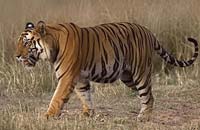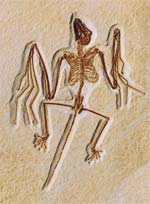 The spinal column that runs down your back is an identity badge that signifies your membership among the vertebrates – animals with backbones. Vertebrates have arguably the most complex bodies and genomes of any animal group and certainly, our lineage has come a long way from its last common ancestor.
The spinal column that runs down your back is an identity badge that signifies your membership among the vertebrates – animals with backbones. Vertebrates have arguably the most complex bodies and genomes of any animal group and certainly, our lineage has come a long way from its last common ancestor.
 The closest evolutionary cousins of the vertebrates are simple aquatic creatures such as the jawless lancelets and the sac-like, immobile sea squirts. How did these simple body plans diversify into the vast array of sophisticated forms wielded by today’s fish, amphibians, reptiles and mammals?
The closest evolutionary cousins of the vertebrates are simple aquatic creatures such as the jawless lancelets and the sac-like, immobile sea squirts. How did these simple body plans diversify into the vast array of sophisticated forms wielded by today’s fish, amphibians, reptiles and mammals?
Gene number
Many scientists have suggested that the answer lies in the number of our genes. At three different points, the vertebrate genome (its full suite of genes) experienced a massive jump in size as huge chunks of genes – possibly the entire lot – were duplicated. The first of these coincided with the origins of the group itself and the second happened alongside the rise of the first jawed fish, setting them and their descendants aside from more ancient jawless forms like the lampreys.
So far, there seems to be a tidy connection between gene number and complexity, but the third round of duplication is a bit of a stumbling block. It happened at some point during the evolution of the bony fishes and while this group proceeded to radiate into a multitude of different shapes, their basic body plan stayed essentially the same. No big jump in complexity there.
Indeed, as the full genome sequences of more and more species are revealed, it’s becoming clear that the basic genetic toolkit that controls the development of animal bodies is remarkably consistent across the kingdom. Even the genome of a sea anemone, one of the simplest and most ancient animals on Earth, is strikingly similar to that of vertebrates.
In this light, it’s looking increasingly unlikely that the advent of new genes can account for the large rise in vertebrate complexity. Now, Alysha Heimberg and colleagues from Dartmouth College have proposed a new theory, centred around tiny molecules called microRNAs.
Continue reading →
Filed under: Animal evolution, Animal kingdom, Evolution, Genetics, Genomes, Junk DNA | Tagged: complexity, gene evolution, macroevolution, microRNAs, RNAs, science, vertebrates | 4 Comments »









 The closest evolutionary cousins of the vertebrates are simple aquatic creatures such as the jawless
The closest evolutionary cousins of the vertebrates are simple aquatic creatures such as the jawless  Because of the way our education system works, this process of hard studying has become almost synonymous with the act of learning, and the inevitable tests and exams that bookend this ordeal merely assess how much information has stuck.
Because of the way our education system works, this process of hard studying has become almost synonymous with the act of learning, and the inevitable tests and exams that bookend this ordeal merely assess how much information has stuck. The success of bats hinges on two key abilities: their mastery of flight, a feat matched only by birds and insects; and
The success of bats hinges on two key abilities: their mastery of flight, a feat matched only by birds and insects; and  Sex chromosomes aside, every person has two copies of each gene, one inherited from their father and one by their mother. Not every gene will be in correct working order, but there’s a good chance that a faulty copy will be offset by a functional one from the other parent.
Sex chromosomes aside, every person has two copies of each gene, one inherited from their father and one by their mother. Not every gene will be in correct working order, but there’s a good chance that a faulty copy will be offset by a functional one from the other parent.
 Languages are often compared to living species because of the way in which they diverge into new tongues over time in an ever-growing linguistic tree. Some critics have claimed that this comparison is a superficial one, a nice metaphor but nothing more.
Languages are often compared to living species because of the way in which they diverge into new tongues over time in an ever-growing linguistic tree. Some critics have claimed that this comparison is a superficial one, a nice metaphor but nothing more. In the words of Edward O. Wilson, the entire lineage seems “poised to expand.” The Great Lakes of Africa – Tanganyika, Malawi and Victoria – swarm with a multitude of different species;
In the words of Edward O. Wilson, the entire lineage seems “poised to expand.” The Great Lakes of Africa – Tanganyika, Malawi and Victoria – swarm with a multitude of different species;  Chameleons are a group of small lizards that are almost synonymous with camouflage. Common folklore has it that their vaunted ability to change their skin colour allows them to go undetected in a variety of environments.
Chameleons are a group of small lizards that are almost synonymous with camouflage. Common folklore has it that their vaunted ability to change their skin colour allows them to go undetected in a variety of environments.


